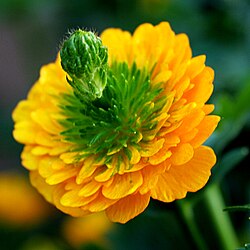Biology:Virescence
Virescence is the abnormal development of green pigmentation in plant parts that are not normally green, like shoots or flowers (in which case it is known as floral virescence).[1] Virescence is closely associated with phyllody (the abnormal development of flower parts into leaves) and witch's broom (the abnormal growth of a dense mass of shoots from a single point). They are often symptoms of the same disease affecting the plants, typically those caused by phytoplasmas.[2] The term chloranthy is also sometimes used for floral virescence, though it is more commonly used for phyllody.[3]
The term was coined around 1825, from Latin virescere, "to become green". In the English language the term virescent may also refer to greenness (cf. verdant).[4]
See also
- Chlorosis
- Forest pathology
- Phytopathology
References
- ↑ Masters, M.T. (1869). Vegetable Teratology, an Account of the Principal Deviations from the Usual Construction of Plants. Robert Hardwicke. p. 240–281. https://archive.org/details/vegetableteratol00mastuoft.
- ↑ Hogenhout, S.A.; Šeruga Musić, M. (2010). "Phytoplasma Genomics, from Sequencing to Comparative and Functional Genomics – What Have We Learnt?". Phytoplasmas: Genomes, Plant Hosts and Vectors. CABI. pp. 19–37. ISBN 9781845935306. https://archive.org/details/phytoplasmasgeno00wein.
- ↑ Shastri, V. (2005). Academic Dictionary Of Biology. Isha Books. ISBN 9788182051874.
- ↑ "Virescent". Academic Dictionaries and Encyclopedias. http://en.academic.ru/dic.nsf/cide/193236/Virescent.
 |


